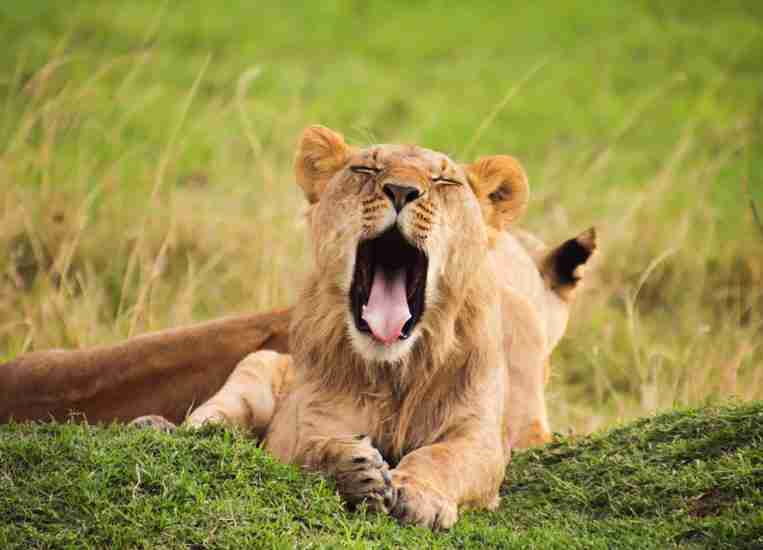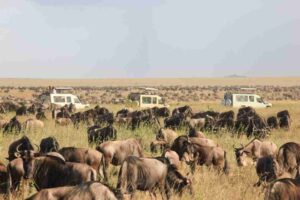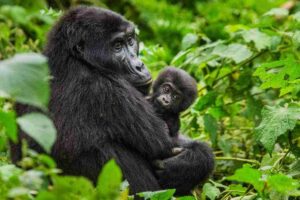Big Cats and Big five East Africa Wildlife safaris in Kenya and Tanzania with Adeli Kenya Safaris

The African savanna is synonymous with its iconic Big cats wild animals of Africa: lions, leopards, and cheetahs. These magnificent predators hold a vital role in the ecosystem, captivating observers with their power, grace, and hunting prowess.
Witnessing these magnificent Big Cats in their natural African habitats is a highlight of any safari, offering a glimpse into the raw power and beauty of the wild. Conservation efforts are crucial to ensure the survival of these iconic species for future generations.
Read more about BBC’s Big Cat Diary
Buy an Ebook on Big cats by the award-winning photographers and conservationists Jonathan Scott and Angela Scott (the big cat people) who have participated in many travel documentaries including Big Cat Diary.
Cheetahs Meet Film Crew YouTube video| BBC Studios
- Social Structure: Lions are unique among big cats for their social nature, living in groups called prides consisting of related females, their cubs, and a few dominant males.
- Physical Characteristics: Adult males are easily recognizable by their impressive manes, a sign of virility and dominance. They are powerful and muscular, averaging 184-208 cm (72-82 inches) in head-and-body length and weighing 186-225 kg (411-496 lbs). Females are smaller, averaging 160-184 cm (63-72 inches) in length and weighing 118-143 kg (261-316 lbs).
- Habitat and Distribution: African lions primarily inhabit grasslands, savannas, and open woodlands across sub-Saharan Africa. Historically widespread, their populations have significantly declined, and they are now classified as vulnerable. Major populations remain in East and Southern Africa, with Tanzania holding three of the five largest populations.
- Hunting Behavior: Lionesses typically coordinate hunts, preying on medium to large ungulates like zebra and wildebeest. Males primarily defend the pride’s territory.
- Conservation Status: Listed as Vulnerable due to habitat loss, human-wildlife conflict, and illegal wildlife trade.
Best places to see lions in Kenya and Tanzania:
Kenya and Tanzania are renowned for their healthy lion populations and offer exceptional opportunities for sightings. Here are some of the best places to see lions in these East African countries:
Kenya
Kenya is estimated to have around 2,500 lions, making it a significant stronghold for the species.
- Maasai Mara National Reserve: This is arguably the best place in Kenya and one of the top locations in Africa for lion sightings. The open grasslands make spotting them easier, and the high concentration of prey, especially during the Great Wildebeest Migration (roughly July to October), supports a large lion population (estimated over 900). The Musiara pride is particularly famous and often featured in wildlife documentaries. The conservancies bordering the Mara, such as Mara North, Naboisho, and Olare Motorogi, also offer excellent viewing opportunities, often with a more exclusive experience.
- Tsavo East and Tsavo West National Parks: The largest national park in Kenya, Tsavo is home to a significant lion population (around 675). These parks offer a different landscape with vast wilderness, including open plains and acacia scrub. The Tsavo lions are known for some males lacking prominent manes.
- Amboseli National Park: Situated near Mount Kilimanjaro, Amboseli offers stunning views and a good lion population (around 200). The lions here are known for their golden cubs.
- Samburu National Reserve: Located in northern Kenya, Samburu has a healthy lion population, often found along the Ewaso Ngiro River, where prey is abundant.
- Nairobi National Park: Surprisingly, this park is located just 7 km from Nairobi city and hosts a resident lion population (around 45). While sightings might not be as frequent as in larger parks, it offers a unique opportunity to see lions against the backdrop of the city skyline.
- Lake Nakuru National Park: Known for its flamingoes, Lake Nakuru also hosts a lion population (around 65) that can be spotted around the lake and surrounding grasslands.
- Laikipia Conservancies (e.g., Ol Pejeta Conservancy, Lewa Wildlife Conservancy): These private conservancies are crucial for conservation and offer excellent wildlife viewing, including several lion prides. Ol Pejeta is known to have a significant lion population (around 90), and Lewa also supports a healthy number.
Tanzania
Tanzania boasts the largest lion population in Africa, estimated at around 14,500.
- Serengeti National Park: Famed for the Great Migration, the Serengeti is also home to a vast lion population (around 3,000), the largest in Africa. The open plains provide excellent visibility, and the abundance of prey ensures frequent sightings. The eastern Serengeti, around the Namiri Plains, is particularly rewarding.
- Ngorongoro Conservation Area (including the Crater): The unique ecosystem of the Ngorongoro Crater supports a high density of wildlife, including a significant lion population (around 65-75). The crater’s enclosed environment often leads to interesting lion dynamics and close-range viewing.
- Lake Manyara National Park: Famous for its tree-climbing lions, Lake Manyara offers a unique perspective on these big cats. While not as numerous as in the Serengeti, seeing lions lounging in acacia trees is a memorable experience.
- Ruaha National Park: Located in southern Tanzania, Ruaha is the largest national park in the country and supports a substantial lion population (over 1,000), representing a significant portion of Africa’s total lion numbers. The rugged landscape and the Great Ruaha River attract a high concentration of wildlife.
- Nyerere National Park (formerly Selous Game Reserve): This vast protected area in southern Tanzania is home to a significant lion population (estimated between 1,700 and 6,900 in the greater Selous ecosystem). The diverse habitats support a wide range of wildlife and lion prides.
- Tarangire National Park: Known for its large elephant herds and baobab trees, Tarangire also offers good lion sightings, particularly along the Tarangire River, especially during the dry season.
Best Time to See Lions:
While lions can be seen year-round, the dry seasons in both Kenya (June to October, December to February) and Tanzania (June to October, December to February) are generally considered the best times for wildlife viewing. During these periods, vegetation is less dense, making it easier to spot animals, and they tend to congregate around water sources.
Leopards: The Elusive Solitary Hunters
- Solitary Nature: Leopards are predominantly nocturnal and solitary animals, each maintaining a home range.
- Physical Characteristics: They are powerfully built with a tawny or light yellow coat marked with distinctive black rosettes. Their size varies, with males averaging 1.6 to 2.3 meters (5 to 7.5 feet) in length and weighing 37 to 90 kg (80 to 200 pounds). Females are smaller, weighing 27 to 59 kg (60 to 130 pounds).
- Habitat and Distribution: Highly adaptable, leopards inhabit a wide range of environments across sub-Saharan Africa, from rainforests and rocky landscapes to savannas and even urban fringes.
- Hunting Behavior: Leopards are skilled stalkers and ambush predators with a diverse diet, including mammals, reptiles, birds, and even fish. They are also known for their strength in climbing trees, often carrying their kills to avoid scavengers.
- Conservation Status: Classified as Vulnerable due to habitat loss, human-wildlife conflict, and the illegal trade in their pelts and body parts.
Best places to see Leopards in Kenya and Tanzania:
Kenya and Tanzania are both excellent destinations for leopard sightings, though these elusive cats can sometimes be challenging to spot due to their solitary and often nocturnal nature. Here are some of the best places in each country to increase your chances:
Kenya
Kenya boasts a healthy leopard population, and certain areas are particularly renowned for sightings:
- Maasai Mara National Reserve & Conservancies: The Mara is consistently ranked as one of the top places in Africa for leopard sightings. The riverine woodlands, especially along the Mara River and its tributaries, provide ideal habitat. The private conservancies bordering the main reserve (Mara North, Naboisho, Olare Motorogi, etc.) often offer even more exclusive and frequent sightings due to lower vehicle density and knowledgeable guides. Look for leopards resting in trees during the day or becoming more active at dawn and dusk.
- Specific Camps with High Sighting Records: Offbeat Ndoto, Basecamp Leopard Hill, Sala’s Camp, Kicheche Bush Camp, Hemingways Ol Seki Mara.
- Samburu National Reserve: This arid and dramatic landscape with rocky outcrops and riverine bush along the Ewaso Ngiro River is often called the “leopard capital of Kenya.” The unique vegetation and terrain provide excellent vantage points for these cats.
- Laikipia Conservancies (e.g., Ol Pejeta, Lewa, Loisaba): These private conservancies are strongholds for various wildlife, including healthy leopard populations. Laikipia is also famous for its black leopard sightings, particularly around Laikipia Wilderness Camp. The diverse habitats, from open plains to rocky areas and woodlands, support a good number of leopards.
- Tsavo National Parks (East & West): The vast wilderness of Tsavo offers a different environment for leopards. While sightings might be more sporadic than in the Mara or Samburu, the diverse habitats, including rocky hills and riverine areas, are home to these adaptable cats.
- Amboseli National Park: While famous for its elephants and Kilimanjaro views, Amboseli also has a leopard population. Look for them in the acacia woodlands and riverine areas.
- Lake Nakuru National Park: Known for its flamingoes, this park also supports leopards, often seen around the yellow-barked acacia (fever) trees.
Tanzania
Tanzania, with the largest lion population in Africa, also offers excellent leopard viewing opportunities in several key areas:
- Serengeti National Park: Particularly the central Seronera Valley, is considered one of the best places in Tanzania to see leopards. The high density of prey and the presence of kopjes (rocky outcrops) provide ideal habitat. Look for them resting on rocks or in trees along the rivers. The Grumeti River area is also known for good sightings.
- Specific Camps with High Sighting Records: Alex Walker’s Serian Serengeti, Lemala Mara-Ndutu, Kuro Tarangire, Lamai Serengeti, Kati Kati Camp.
- Ngorongoro Conservation Area (including the Crater): The crater’s rim forests and the bushy areas within the crater provide habitat for leopards. While sightings might require more patience than in the open plains of the Serengeti, the unique environment supports a variety of predators.
- Lake Manyara National Park: Famous for its tree-climbing lions, Lake Manyara also has a good leopard population that can be found in the dense forests and woodlands surrounding the lake. Keep an eye on the branches of acacia and fig trees. Night game drives here can increase your chances.
- Ruaha National Park: Located in southern Tanzania, Ruaha is a less crowded park with a significant leopard population. The riverine woodlands along the Great Ruaha River are prime leopard territory. Guides here often have good knowledge of individual cat locations.
- Tarangire National Park: Known for its large elephant herds and baobab trees, Tarangire also offers good leopard sightings, especially during the dry season when animals concentrate along the Tarangire River. Look for them in the trees and along the riverbanks.
- Nyerere National Park (formerly Selous Game Reserve): This vast southern park has a healthy leopard population, though sightings can be more sporadic due to the dense vegetation in parts. Riverine areas and woodlands are good places to search.
Tips for Seeing Leopards:
- Go on morning and late afternoon/early evening game drives: Leopards are most active during these cooler times.
- Look in trees: Leopards often rest and hunt from the branches of large trees.
- Listen for alarm calls: Monkeys, baboons, and birds often give alarm calls when a leopard is nearby.
- Go on night drives (where permitted): As nocturnal animals, leopards are often more active at night, and spotlights can help with sightings.
- Have an experienced guide: Local guides are often familiar with the territories and habits of individual leopards, significantly increasing your chances.
- Be patient: Leopard sightings are never guaranteed, so patience is key. Enjoy the other wildlife and the overall safari experience.
Combining a safari that visits some of these key locations in both Kenya and Tanzania will give you the best possible chance of encountering these magnificent and elusive big cats in their natural habitat.
Cheetahs: The Speed Kings
- Speed and Agility: Cheetahs are the fastest land animals, capable of reaching speeds over 100 km/h (60 mph) in short bursts. Their slender build, long legs, and flexible spine are adaptations for high-speed pursuit.
- Physical Characteristics: They have a tan coat with solid black spots and distinctive black “tear marks” running from their eyes to their mouths. Adults measure 110-150 cm (43-59 inches) in head-and-body length and weigh between 35 and 65 kg (77 and 143 pounds).
- Habitat and Distribution: Cheetahs prefer open grasslands, savannas, and woodlands, where their speed can be utilized for hunting. Their populations have significantly declined and fragmented across Africa, with strongholds remaining in East and Southern Africa, particularly in areas like the Serengeti-Mara ecosystem.
- Hunting Behavior: Primarily diurnal hunters, cheetahs rely on their speed to chase down medium-sized antelopes, such as gazelles and impalas.
- Conservation Status: Listed as Vulnerable, facing threats from habitat loss, human-wildlife conflict, prey depletion, and competition with larger predators.
Best places to see Cheetahs in Kenya and Tanzania:
Kenya and Tanzania are both excellent destinations for cheetah sightings, thanks to their expansive open plains and healthy prey populations. Here are some of the best places to see these swift predators in each country:
Kenya
Kenya is home to a significant cheetah population, estimated at around 1,300 individuals.
- Maasai Mara National Reserve & Conservancies: The Mara, with its vast open grasslands, is arguably the best place in Kenya for cheetah sightings. The high concentration of prey, especially during the Great Wildebeest Migration (July to October), provides ample hunting opportunities for cheetahs. The surrounding private conservancies (Mara North, Naboisho, Olare Motorogi, etc.) often offer even more exclusive and frequent sightings. The Mara Cheetah Project actively monitors the local population, aiding in understanding their movements and behaviors.
- Samburu National Reserve: Located in the arid northern region of Kenya, Samburu’s open landscapes and the presence of the Ewaso Ngiro River attract a good number of cheetahs. The sparse vegetation makes them relatively easier to spot.
- Laikipia Conservancies (e.g., Ol Pejeta, Lewa): These conservancies are strongholds for various wildlife, including cheetahs. The mix of open plains and bushland provides suitable habitats. Ol Pejeta Conservancy is known for its conservation efforts and offers good chances of seeing cheetahs.
- Tsavo East National Park: The vast open plains of Tsavo East provide ideal hunting grounds for cheetahs. While sightings might be more spread out due to the park’s size, the landscape is conducive to spotting them. The area east of Aruba Dam is often favored.
- Amboseli National Park: Famous for its stunning views of Mount Kilimanjaro, Amboseli’s open plains are also home to cheetahs. They can often be seen hunting gazelles and other plains game against the backdrop of the majestic mountain.
- Lake Nakuru National Park: While primarily known for its flamingos, Lake Nakuru’s surrounding grasslands also support a cheetah population.
Tanzania
Tanzania boasts a larger cheetah population and equally rewarding viewing opportunities, particularly in the northern circuit.
- Serengeti National Park: The Serengeti’s seemingly endless open plains provide the ** quintessential cheetah habitat**. With a large and healthy cheetah population, sightings are frequent, especially in the Seronera Valley (central Serengeti) and the plains of the southern Serengeti during the wildebeest calving season (roughly December to March). The Namiri Plains in the eastern Serengeti are particularly renowned for cheetah sightings, as this area was previously used for big cat research and has several breeding females.
- Ngorongoro Conservation Area (including the Crater): While the crater itself has a relatively smaller cheetah population compared to the Serengeti, the open grasslands within the caldera still offer chances to see them. The stunning backdrop of the crater makes any sighting particularly memorable. The Ndutu area, bordering the southern Serengeti, which falls within the Ngorongoro Conservation Area, is also excellent during calving season.
- Tarangire National Park: Often overshadowed by its more famous neighbors, Tarangire has a healthy cheetah population. The open woodlands and grasslands, especially during the dry season (June to October) when wildlife concentrates along the Tarangire River, offer good viewing opportunities.
- Ruaha National Park: Located in southern Tanzania, Ruaha is a vast and less crowded park with a significant cheetah population. The open grasslands and riverine areas are favored hunting grounds.
- Nyerere National Park (formerly Selous Game Reserve): This massive reserve in southern Tanzania has a good cheetah population, though the denser vegetation in parts can make sightings more challenging than in the Serengeti. Open savannah areas are the best places to look.
Best Time to See Cheetahs:
While cheetahs can be seen year-round, the dry seasons in both Kenya (June to October, December to February) and Tanzania (June to October, December to February) are generally considered optimal for sightings. During these times:
- Vegetation is shorter and less dense: This improves visibility, making it easier to spot cheetahs across the open plains.
- Prey animals congregate around water sources: This can increase the chances of seeing cheetahs hunting.
When planning your safari, consider focusing on the open grassland ecosystems within these parks and reserves to maximize your chances of witnessing the incredible speed and agility of the African cheetah. Engaging experienced guides who are familiar with cheetah territories and behavior will also significantly enhance your sighting opportunities.














